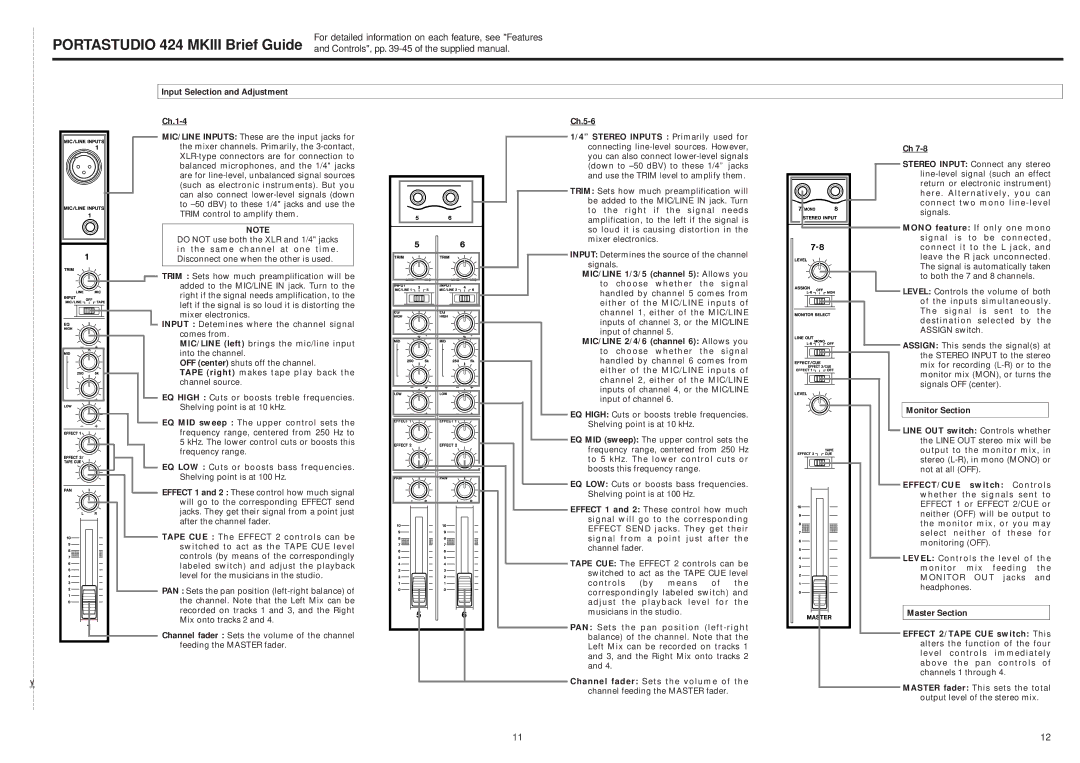
PORTASTUDIO 424 MKIII Brief Guide | For detailed information on each feature, see "Features |
and Controls", pp. | |
|
|
Input Selection and Adjustment
Ch.1-4
MIC/LINE INPUTS: These are the input jacks for
the mixer channels. Primarily, the
NOTE
DO NOT use both the XLR and 1/4" jacks in the same channel at one time. Disconnect one when the other is used.
![]() TRIM : Sets how much preamplification will be
TRIM : Sets how much preamplification will be
added to the MIC/LINE IN jack. Turn to the
right if the signal needs amplification, to the left if the signal is so loud it is distorting the mixer electronics.
INPUT : Detemines where the channel signal
comes from.
MIC/LINE (left) brings the mic/line input into the channel.
OFF (center) shuts off the channel.
TAPE (right) makes tape play back the
channel source.
EQ HIGH : Cuts or boosts treble frequencies.
Shelving point is at 10 kHz.
EQ MID sweep : The upper control sets the
frequency range, centered from 250 Hz to
5 kHz. The lower control cuts or boosts this
frequency range.
EQ LOW : Cuts or boosts bass frequencies.
Shelving point is at 100 Hz.
EFFECT 1 and 2 : These control how much signal
will go to the corresponding EFFECT send
jacks. They get their signal from a point just after the channel fader.
TAPE CUE : The EFFECT 2 controls can be switched to act as the TAPE CUE level controls (by means of the correspondingly labeled switch) and adjust the playback
level for the musicians in the studio.
PAN : Sets the pan position
Channel fader : Sets the volume of the channel feeding the MASTER fader.
✂
1/4” STEREO INPUTS : Primarily used for connecting
TRIM: Sets how much preamplification will be added to the MIC/LINE IN jack. Turn to the right if the signal needs amplification, to the left if the signal is so loud it is causing distortion in the mixer electronics.
INPUT: Determines the source of the channel
signals.
MIC/LINE 1/3/5 (channel 5): Allows you
to choose whether the signal
handled by channel 5 comes from either of the MIC/LINE inputs of channel 1, either of the MIC/LINE
inputs of channel 3, or the MIC/LINE
input of channel 5.
MIC/LINE 2/4/6 (channel 6): Allows you to choose whether the signal handled by channel 6 comes from either of the MIC/LINE inputs of channel 2, either of the MIC/LINE inputs of channel 4, or the MIC/LINE input of channel 6.
EQ HIGH: Cuts or boosts treble frequencies.
Shelving point is at 10 kHz.
EQ MID (sweep): The upper control sets the frequency range, centered from 250 Hz to 5 kHz. The lower control cuts or boosts this frequency range.
EQ LOW: Cuts or boosts bass frequencies.
Shelving point is at 100 Hz.
EFFECT 1 and 2: These control how much signal will go to the corresponding EFFECT SEND jacks. They get their signal from a point just after the channel fader.
TAPE CUE: The EFFECT 2 controls can be switched to act as the TAPE CUE level controls (by means of the correspondingly labeled switch) and adjust the playback level for the musicians in the studio.
PAN: Sets the pan position
Channel fader: Sets the volume of the channel feeding the MASTER fader.
Ch
STEREO INPUT: Connect any stereo
MONO feature: If only one mono signal is to be connected, connect it to the L jack, and leave the R jack unconnected.
The signal is automatically taken
to both the 7 and 8 channels.
LEVEL: Controls the volume of both of the inputs simultaneously. The signal is sent to the destination selected by the ASSIGN switch.
ASSIGN: This sends the signal(s) at the STEREO INPUT to the stereo
mix for recording
Monitor Section
LINE OUT switch: Controls whether the LINE OUT stereo mix will be output to the monitor mix, in stereo
EFFECT/CUE switch: Controls whether the signals sent to EFFECT 1 or EFFECT 2/CUE or neither (OFF) will be output to the monitor mix, or you may select neither of these for monitoring (OFF).
LEVEL: Controls the level of the monitor mix feeding the MONITOR OUT jacks and headphones.
Master Section
EFFECT 2/TAPE CUE switch: This alters the function of the four level controls immediately above the pan controls of channels 1 through 4.
MASTER fader: This sets the total output level of the stereo mix.
11 | 12 |
